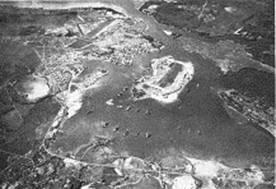![]() The Pacific War Online Encyclopedia
The Pacific War Online Encyclopedia
|
| Previous: Portland Class, U.S. Heavy Cruisers | Table of Contents | Next: Portugal |

Ports are where land meets sea. They are installations
equipped to dock ships,
load and unload their cargoes, provide logistical services, and shelter
ships from storms. The U.S.
Navy raised units called Cubs and Lions to organize naval bases at
ports: A Cub was capable of developing a medium-sized forward naval
base, while a Lion was capable of developing a major naval base.
A modern port included:
Docks. Ships in port could not load or unload efficiently except at docks, where a landing was built next to water deep enough to accommodate the ship. A modern dock was equipped with cranes and rail spurs to allow the ship to be loaded or unloaded directly to a rail car for transport inland. In the absence of docks, as at Guadalcanal early in the war, ships had to be unloaded by lighter (small boats or landing craft), which was a slow and manpower-intensive process.
A rough rule of thumb was that a single berth could
load or unload six ships per month.
Seagoing ships usually required the assistance of tugs to help them through the
channel connecting the docks to the open sea.
Anchorages. It was useful, particularly for naval bases, to have a sizable anchorage for ships sheltering from storms or otherwise not in need of actual dock space.
Breakwaters.
Ships in port needed protection from wind
and waves. Natural harbors such as San Francisco Bay were almost
completely surrounded by land that provided such protection. Such
harbors are uncommon, and artificial harbors such as Colombo or Los Angeles had man made
breakwaters. A port with little natural protection is referred to as a
road stead.
Logistics.
Ships require fuel oil and other
provisions to operate. Modern ports had tank farms and refueling
facilities adequate to support the traffic through the port. These were
vulnerable to attack, and Nagumo
has been heavily criticized for failing to destroy the tank farms
surrounding Pearl Harbor
during the attack of 7 December 1941 that marked the outbreak of war.
Warships also require ammunition dumps from which to replenish their
magazines. The United States
attempted with considerable success to substitute for modern port
facilities with an extensive fleet train of oilers, provisions ships, ammunition ships, and other
supply ships that could resupply fleets at advance bases or even on the
high seas. Japan also made use of underway replenishment, particularly
refueling at sea, but not nearly as successfully as the Americans.
However, the fleet train ultimately had to extend back to a modern port
with the necessary logistical facilities.
The Americans rapidly expanded logistical facilities at major ports they intended to keep after the war, such as Pearl Harbor and Guam. At other advanced bases, such as Ulithi, the Americans used obsolete tankers, each with a capacity of 60,000 to 80,000 barrels (8000 to 11,000 tons), to serve as floating tank farms.
Defense. Ships
in port are unable to maneuver, which is one of their best defenses
against bombing or torpedo attack, and important ports
were equipped with abundant antiaircraft
and with torpedo nets to foil torpedo attack. The nets were opened or
closed as required by small net
tenders. In addition, the port might be protected by minefields. Important ports
invariably had airfields
basing fighters nearby as well as
the best radar available.
Maintenance. Ships require repairs and maintenance, and modern ports had extensive machine shops to perform the necessary work.
References
The Pacific War Online Encyclopedia © 2007-2009 by Kent G. Budge. Index